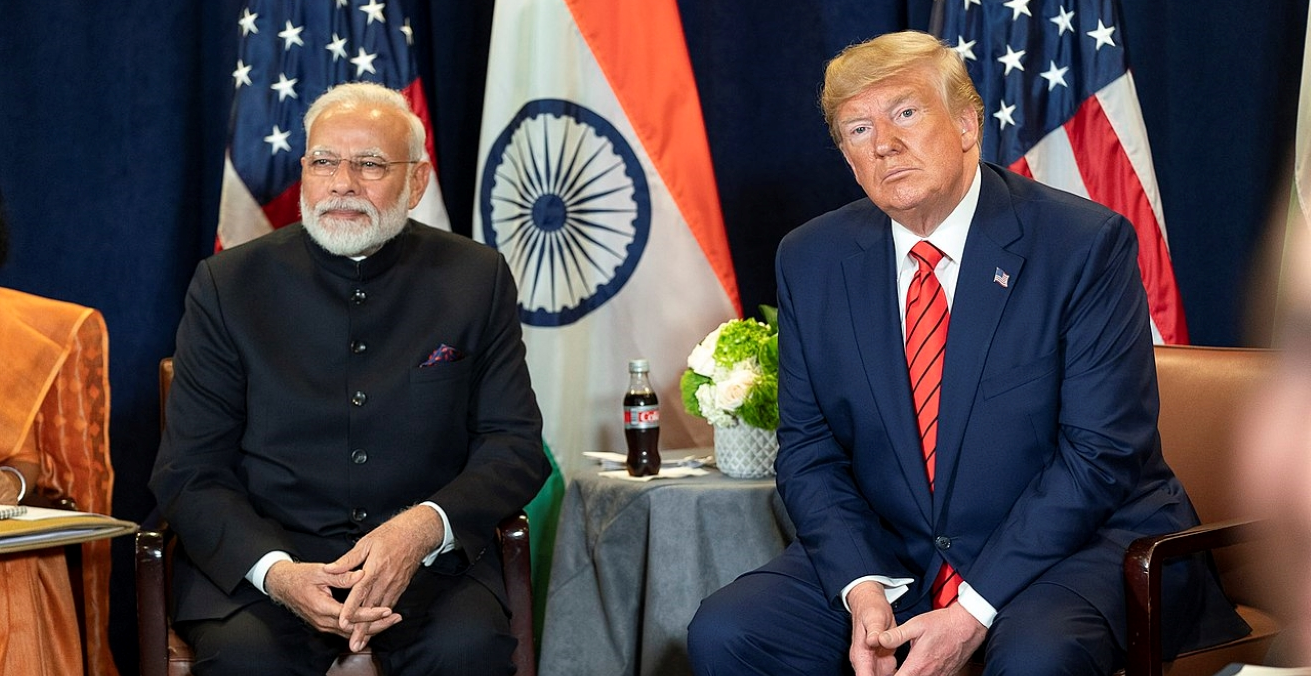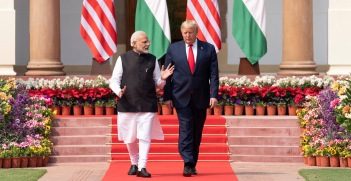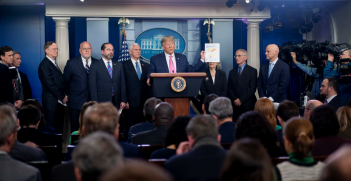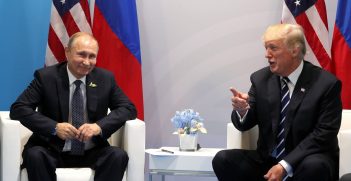President Trump’s Maiden Visit to India: Trade and Defence Top on the Agenda

Relations between India and the US are underpinned by their shared democratic values and strengthened by an extraordinary level of convergence of interests, especially the security concerns arising from terrorism and the assertive posture of China in the Indo-Pacific region. Hopefully, President Donald Trump’s maiden visit to India will further strengthen the US-India strategic partnership which is touted as the “defining partnership” of the 21st century.
President Trump arrives in India today for a two-day state visit. During this time, Trump will meet Prime Minister Narendra Modi and stakeholders in US-India relations. Before heading to Delhi on 25 February to discuss trade, defence, and security to underpin the US-India strategic partnership, Trump will visit Ahmedabad in Modi’s home state of Gujarat to attend the “Namaste Trump” event , similar to the “Howdy Modi” event held in Houston in 2019. Trump will inaugurate the world’s largest cricket stadium in Motera, with 7 million people expected to greet him between the airport and the stadium.
Trump’s visit is happening against a backdrop of forthcoming US presidential elections and India’s removal of Article 370 in 2019, which had granted the special status to the Indian state of Jammu and Kashmir. Namaste Trump is expected to help Trump attract Indian American voters for his bid at a second term in the White House. Trump made an appearance at Howdy Modi with the same objective.
This visit is significant for the US-India strategic partnership, which is deeply rooted in the convergence of strategic interests in the post-9/11 Islamic terrorism security threat environment and the steady rise of an assertive China. Both nations will try to resolve the trade deal, which has become a nagging issue in the strategic partnership.
Indian Americans, Kashmir, and India-Pakistan Lobbying
Indian Americans have emerged as a significant political force, though they account for just over one percent of the US population. They exert significant influence through campaign donations and fundraising. Though there has been an increase in Republican Indian-American voters, the Indian-American community has traditionally voted for the Democratic Party.
Nevertheless, Republican President George W. Bush attracted considerable numbers of IndianAmerican voters. Favourable US foreign policy towards India during Bush’s first term, culminating in the nuclear deal ending India’s nuclear isolation, was a major cause for this shift. Trump has a similar opportunity during his second term to appeal to Indian-American voters.
Trump’s India visit is significant also in the context of India’s removal of two temporary provisions in the Indian Constitution (Articles 35A and 370), which granted special status to Jammu and Kashmir, as well as India’s campaign against cross-border terrorism backed by Pakistan-based terror organisations and Pakistan’s inaction against these organisations. After the revocation of Article 370, Pakistan mounted an intense lobbying campaign in Washington against India on the Kashmir issue. Pakistani Prime Minister Imran Khan requested Trump for US-led mediation in the Kashmir issue.
India has also resorted to diplomacy and lobbying. Modi has asserted that Article 370 is India’s internal matter and the Kashmir issue will be solved by India and Pakistan. Since the 1990s, India has been countering Pakistani lobbying through lobbying firms, the Indian American community, and the India Caucus.
The India-Pakistan tussle has revived on Capitol Hill, with both countries lobbying intensely to prove their points. However, unlike during the Cold War, the Indian lobby is far more powerful than Pakistani lobby. After the revocation of Article 370, Indian lobbying has been successful in getting its message through to the Trump administration, which has stated that the Kashmir issue should be resolved between India and Pakistan. Trump’s India visit further vindicates the Indian lobbying efforts and India’s stand on Kashmir.
Trade Deal: A Nagging Issue
During the visit, Trump is expected to clinch a limited trade deal. Throughout Trump’s presidency, trade issues have been a nagging point in India-US relations. The US is India’s biggest trading partner for goods and services, followed by China. Trump has criticised India on balance of payments and tariff issues. India has a trade surplus of $31 billion. However, casting doubts on the likelihood of a trade deal with India, Trump said “Well, we can have a trade deal with India, but I’m really saving the big deal for later on.”
Trump removed India from the list of countries with tariff-free access to the US market. Since then, both countries have been trying to clinch a manageable deal through which India’s preferential trade status could be restored. The trade volume between India and the US has grown ten-fold over the past two decades, with total bilateral trade at $142 billion in 2018. The US-India Strategic and Partnership Forum (USISPF) projects US-India bilateral trade will reach $238 billion by 2025, with a 7.5 percent average annual rate of growth. With an even higher growth rate, it could reach between $283 billion to $327 billion. Both countries offer immense complementariness in bilateral business and need to tap into each other’s market.
Defence and Strategic Partnership
While in India, Trump will sign a defence deal with Modi, giving final approval for the procurement of 24 Lockheed Martin MH-60 Romeo helicopters worth $2.6 billion to strengthen the Indian Navy’s anti-surface and anti-submarine warfare operational capability.
On the defence commerce and security fronts, the US-India relationship has made significant progress. Bilateral defence trade reached $18 billion in 2019 and significant defence collaboration is expected. Defence is a critical sector in the Modi government’s “Made in India” initiative to enhance India’s manufacturing sector. Since the signing of the Ten Year US-India Defence Agreement in June 2005, and its ten-year extension on June 3, 2015, both countries have been working towards the joint development and manufacture of defence equipment and technology, including the design and construction of jet engines and aircraft carriers. In 2016, India was elevated to “Major Defence Partner,” a status equal to that that of the US’s closest allies for defence trade and technology sharing.
During the Cold War, India relied heavily on the Soviet Union and Russian products continue to dominate India’s defence armoury. However, over the past 10-15 years, India’s efforts to diversify its sources for arms acquisition have brought countries such as Israel, France, and the United States into India’s defence market, with the US replacing Russia as the India’s top arms supplier.
The strategic scenario in the Indo-Pacific, with the militarily assertive posturing of China, the converging security interests of the US and India around not letting the region be dominated by a single power, respect for the rules-based order, free navigation principles, and protection of the global commons, have further underpinned the US-India strategic partnership. Today, the US is the country with which India conducts the largest number of military exercises. Consequently, the mutual trust and interoperability between the Indian and the American armed forces has strengthened. India has emerged as a major Indo-Pacific power, a credible balancer amid receding US hegemonic power and the steady rise of China.
The trade issue must not undermine this deepening strategic partnership that has been built under the previous two US presidents. Trump has called India the “tariff king of the world,” but he also likes Modi. The leadership bonhomie has been a critical factor in the drastic transformation of the relationship between India and the US. This was visible when Bush and Prime Minister Atal Bihari Vajpayee called the US and India “natural allies” and when Obama and Modi pledged to walk together in 21st century. Modi and Trump’s personal bonhomie is well known and their liking for one another is likely to be the key in settling this small but nagging trade issue before it undermines the strategic partnership.
Dr. Ashok Sharma is a Visiting Fellow at the UNSW Canberra at the Australian Defence Force Academy, and an Adjunct Associate Professor at the University of Canberra. Dr. Sharma is also the Deputy Chair of New Zealand Institute of International Affairs at Auckland Branch.
This article is published under a Creative Commons Licence and may be republished with attribution.





